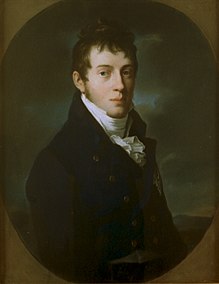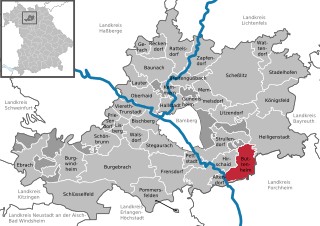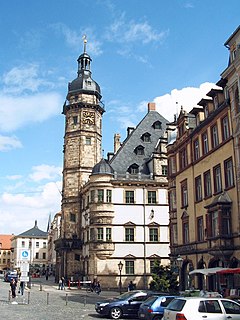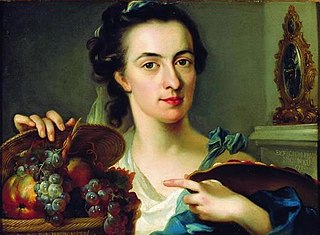
Weimar is a city in the federal state of Thuringia, Germany. It is located in Central Germany between Erfurt in the west and Jena in the east, approximately 80 kilometres southwest of Leipzig, 170 kilometres north of Nuremberg and 170 kilometres west of Dresden. Together with the neighbour-cities Erfurt and Jena it forms the central metropolitan area of Thuringia with approximately 500,000 inhabitants, whereas the city itself counts a population of 65,000. Weimar is well known because of its large cultural heritage and its importance in German history.

Johann Balthasar Neumann, usually known as Balthasar Neumann, was a German architect and military artillery engineer who developed a refined brand of Baroque architecture, fusing Austrian, Bohemian, Italian, and French elements to design some of the most impressive buildings of the period, including the Würzburg Residence and the Basilica of the Fourteen Holy Helpers.

Lothar Franz von Schönborn-Buchheim was the Archbishop-Elector of Mainz from 1694 to 1729 and the Bishop of Bamberg from 1693 to 1729. As Archbishop of Mainz, he was also Archchancellor of the Holy Roman Empire. Lothar Franz von Schönborn is known for commissioning a number of Baroque buildings, such as the palace Schloss Weissenstein.

Friedrich Karl von Schönborn was the Prince-Bishop of Würzburg and Prince-Bishop of Bamberg from 1729 to 1746. He also served as Reichsvizekanzler (Vice-Chancellor) of the Holy Roman Empire from 1705 to 1734.

Prince William Frederick Henry of the Netherlands was the third son of King William II of the Netherlands and his wife, Grand Duchess Anna Pavlovna of Russia. He was born at Soestdijk Palace.

Charles Frederick was the reigning Grand Duke of Saxe-Weimar-Eisenach.

The family of Aufseß, sometimes spelt Aufsees and Aufsess, is a Franconian noble family of barons. The original family seat was at Unteraufseß castle in Aufseß, Upper Franconia.

Ernest Augustus I, Duke of Saxe-Weimar, was a duke of Saxe-Weimar and, from 1741, of Saxe-Weimar-Eisenach.

Schloss Weißenstein is a Schloss or palatial residence in Pommersfelden, Bavaria, southern Germany. It was designed for Lothar Franz von Schönborn, Prince-Bishop of Bamberg and Archbishop of Mainz, to designs by Johann Dientzenhofer and Johann Lukas von Hildebrandt. Weißenstein, built as a private summer residence, remains in the Schönborn family. It is considered a masterwork of Baroque art.

Johann Dientzenhofer was a builder and architect during the Baroque period in Germany.

Buttenheim is a market town in the Upper Franconian district of Bamberg and lies in the Regnitz Valley between Bamberg and Nuremberg, Germany.
Leonhard Dientzenhofer was a German builder and architect from the well known Dientzenhofer family of architects.

Classical Weimar is a UNESCO World Heritage site consisting of 11 sites related to Weimar Classicism located in and around the city of Weimar, Germany. The site was inscribed on 2 December 1998. The properties are all related to Weimar as a centre of the Enlightenment during the eighteenth and early nineteenth centuries. A number of notable writers and philosophers lived there.

Marquard Sebastian Schenk von Stauffenberg (1644–1693) was the Prince-Bishop of Bamberg from 1683 to 1693.

Schloss Weimar is a Schloss (palace) in Weimar, Thuringia, Germany. It is now called Stadtschloss to distinguish it from other palaces in and around Weimar. It was the residence of the dukes of Saxe-Weimar and Eisenach, and has also been called Residenzschloss. Names in English include Palace at Weimar, Grand Ducal Palace, City Palace and City Castle. The building is located at the north end of the town's park along the Ilm river, Park an der Ilm. It forms part of the World Heritage Site "Classical Weimar".

Nikolaus Gromann was an architect of the German Renaissance who served at the court of John Frederick I, Elector of Saxony. He also worked for John Frederick's descendants residing in the cities of Weimar, Gotha and Altenburg, thus spending more than 30 years in the service of the House of Wettin.

Johann Moritz Richter (1620–1667) was a German architect and engraver.

The Park an der Ilm is a large Landschaftspark in Weimar, Thuringia. It was created in the 18th century, influenced by Johann Wolfgang von Goethe, and has not been changed much, preserving a park of the period. It forms part of the World Heritage Site "Classical Weimar".

Schloss Seehof is a Schloss (palace) in Memmelsdorf, Bamberg, Germany. It was built from 1684 to 1695 as a summer residence and hunting lodge for Marquard Sebastian von Schenk von Stauffenberg, Prince-bishop of Bamberg.

Catharina Treu was a German still life painter, and court painter for Charles Theodore, Elector of Bavaria in 1769.





















